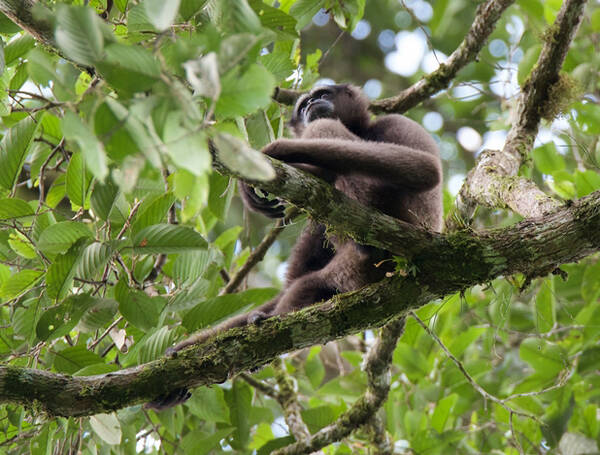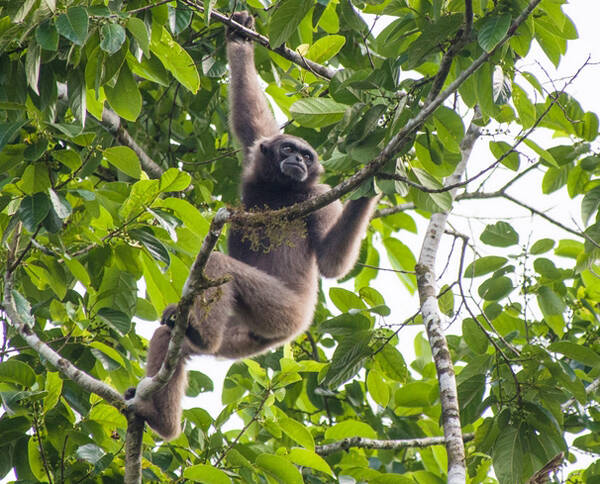Hylobates muelleri
IUCN
LCBasic Information
Scientific classification
- name:Hylobates muelleri
- Scientific Name:Hylobates muelleri,Müller's Bornean Gibbon,Bornean gibbon, Miller's gibbon
- Outline:Primates
- Family:G.family genus
Vital signs
- length:44-63.5cm
- Weight:4-8kg
- lifetime:25-57years
Feature
The hair color varies from gray to brown, with thick and dense white-gray eyebrow lines
Distribution and Habitat
Distributed in Brunei Darussalam, Indonesia (Kalimantan), Malaysia (Sabah). This species has a large overlap with the white-bearded gibbon in central Borneo. In addition, there is a large overlap between the three subspecies.
Mainly inhabits tropical forests. This species lives in primary forests and secondary forests, most often choosing tropical evergreen broad-leaved forests or semi-evergreen rainforests.
Appearance
The gray gibbon is a small ape species. It weighs 4-8 kg and is 440-635 mm long. The coloration of the body hair varies from gray to brown. The hair on the top of the head and chest is darker than the rest of the body. There are hip pads and long canines. The base of the thumb extends from the wrist rather than the palm, which can extend the range of motion. Sexual dimorphism is not obvious.
The legs are short, the palm is longer than the sole, and the finger joints are long; the body is slender, the shoulders are broad and the hips are narrow; there are long canines. There are calluses on the hips, no tail and cheek pouches. There is a sound bag in the throat and it is good at singing.
Details
The gray gibbon (scientific name: Hylobates muelleri) is also known as Müller's Bornean Gibbon in English. It has three subspecies.

A family of gray gibbons usually consists of 4 individuals, including an adult male and an adult female, and the rest are semi-adult and young gibbons, with an adult male as the leader. Gibbons have a relatively long maturity period, and their family relationships are not only stable, but also harmonious and friendly. Family members are generally very harmonious, caring for each other and defending each other. It is also common to see groups of 3 or 4 unrelated solitary apes. These are adult gray gibbons who have been forced to leave their families and have not yet established their own territories.
The habits of gray gibbons are similar to those of other gibbons. They live a family life with male and female spouses and are territorial. The territory of each group is about 34.2 hectares. It is a diurnal animal, active for 8 to 10 hours a day. During the day, it climbs and grabs branches with its arms on the trees 20-30 meters high in the forest, swings and jumps, and uses both its front and rear limbs to move very fast. Due to the high characteristics of this movement, the direction of the chest and arms is often changed. Long-term evolutionary adaptation has made the shoulders flat on both sides, which are not as wide as those of monkeys. The elbows are longer and can rotate 360 degrees in all directions. It can move forward and backward quickly. The feet only play the role of assisting pedaling. It can walk upright on the ground, holding its hands on its head to keep balance when walking. This fashion of walking cannot be maintained for long distances. They don't like swimming and avoid entering water. They have keen hearing and sense of smell, are timid and afraid of cold.
The calls of the gray gibbons are the main way for group members to communicate. Every morning, males and females sing in chorus, usually for 15 minutes, with ups and downs or sad and low sounds. The male's call is sandwiched between the female's call, and at the end of the call, a tail sound is added. Tactile communication is also important, between parents and their offspring. Tactile communication involves grooming, mating, playing, and sometimes aggressive behavior. In addition to vocal and tactile communication, these animals also use facial expressions, gestures and body postures to communicate with their own kind.

Grey gibbons consume large amounts of fruit. Like other gibbons, these animals are primarily frugivores. They also eat a variety of other foods, including leaves, flowers, and insects. Due to their high activity levels, it is necessary to consume calorie-rich foods, and fruits have a high calorie content.
The grey gibbon reaches sexual maturity at 8 years old and has no strict breeding season. Females have an estrus cycle of about 28 days. Although the genitals undergo changes in color and swelling that are thought to be related to ovulation, there is no visible swelling in this species. Males mate more frequently than females. If the female is willing to mate, she will bend forward and accept it. If the female is unwilling, she will ignore the male or leave the mating area. The gestation period of females is about 7 months. After mating and conception, they still move with the group. After 3-4 months, their abdomen will bulge slightly. As the fetus grows, their abdomen gradually increases, and their daily actions become more cautious, but they will still stay with the group until giving birth. Birth usually occurs in autumn and early winter, and only one cub is born per litter. Females will take care of their cubs for up to two years, after which the cubs will continue to live in the family group and help their parents take care of their younger siblings. When they are close to sexual maturity, they will slowly leave the group and live independently. This species reproduces once every 2 to 3 years. Sexual maturity is 8-9 years, life span is about 25 years, and can reach 44 years in captivity, with a record of up to 57 years.
The gray gibbon has been affected by fires and continued deforestation in the 1990s (including legal and illegal logging, drainage of peat swamps, expansion of oil palm plantations, etc.), and its population has dropped sharply. Hunting by humans and habitat degradation are the main reasons for the endangered species.
Protect wild animals and stop eating game.
Maintaining ecological balance is everyone's responsibility!








